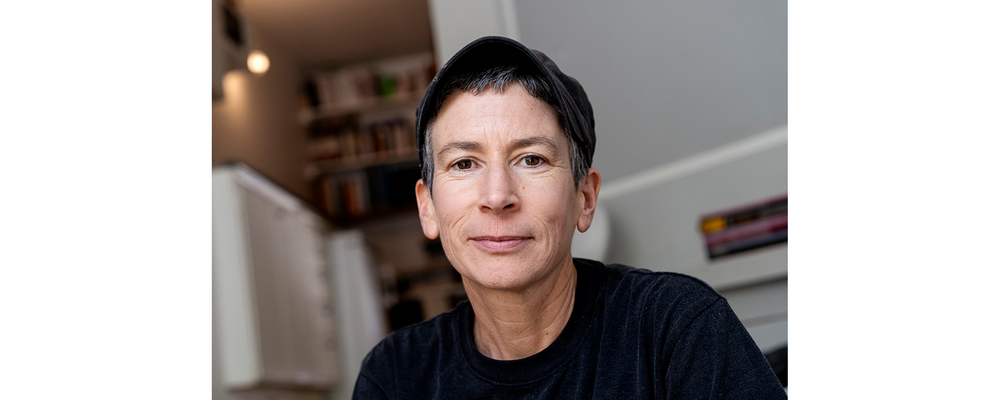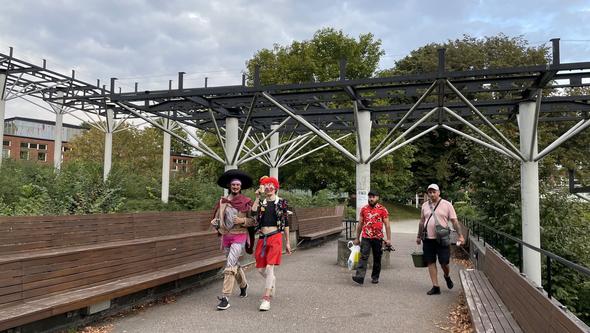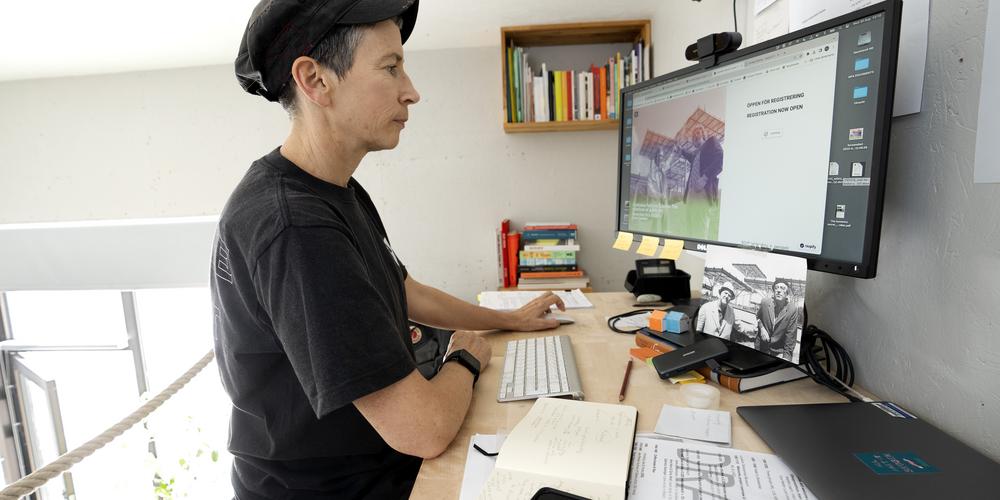
- Home
- Research
- Find research
- A failed fountain sparks conversations about an artwork's afterlife
A failed fountain sparks conversations about an artwork's afterlife
It has been called The LTH Fountain, The Fountain The Fountain, The Salmon Staircase, The Dead Falls, and Fontana di Träti. Names that reflect both love and contempt, and the ruins of the ambitious fountain on the campus of Lund University are both loved and deeply hated. This is one of the many reasons why the object is so interesting, according to Maddie Leach, who leads the research project "The Fountain: An art-technological-social drama," where the LTH Fountain plays a central role.
Maddie Leach has been a university lecturer at HDK-Valand since 2016, and slowly embarked on this research project in 2018 when she first visited the LTH Fountain in Lund. Even then, she was interested in failed artworks and how an artist deals with failure, an interest born from within her own artistic practice.
"My husband grew up in Lund, so the fountain was well-known to him. Over the years, many people in Lund have known about the fountain and have had an opinion on it," says Maddie Leach and goes on;
"I found, and still find, it is fascinating how one deals with failure in artistic practice. Expectations, ambitions, and practical outcomes sometimes collide and collapse, so the question is how to adapt to what cannot be controlled."
Today, the fountain is no longer a fountain but a metal structure of steel pillars and frames. Initially, it contained eleven glass basins, displayed along a 25-meter stretch where water fell from a total height of eleven meters from basin to basin in a series of steps. The impressive and expensive construction was supposed to be inaugurated in connection with Lund University's 300th anniversary in 1968, but due to technical problems, the launch was postponed by two years. Subsequently, there were ongoing issues with leakage, recurring technical breakdowns and repairs, and now it's been almost 30 years since water flowed in the fountain.
"Today, the glass is gone, and the fountain has transformed into something else. LTH students would now not remember a time when it contained water – they see it as simply an odd structure to walk under, perhaps a meeting point to sit and have coffee at. The essential elements of the construction are preserved, but is it the same artwork, a ruin of a previous artwork, or something else?" she says.
During a study visit to the Museum of Sketches in Lund in 2019, Maddie Leach returned to the fountain with MFA students from HDK-Valand.
"The students showed a great interest in the story of the fountain, and asked very interesting questions. It became clear that there was something worth exploring beyond just me having found the artwork fascinating," says Maddie Leach

A fascination with the fountain
Shortly after her second visit to the fountain, Maddie Leach attended a course in writing research projects with the Research and Innovation Office (FIK) and used the LTH Fountain as a basis for a speculative project. This is where the reality of making a viable long-term research project really emerged. Maddie subsequently applied for, and received, a research grant from Formas. The project started in 2021 and is planned to continue until 2025.
"The project explores some ethical dilemmas related to a specific public artwork, but these might also be applicable to other public artworks. I wanted to create a broader context around the LTH Fountain and was looking for similar artistic projects and preferably other well-known examples. I knew the Lund fountain would be part of the project, but initially, I didn't intend for it to take up so much space. However, I became more fascinated by the fountain the more I researched and understood its history," she says.
Its situation on the LTH campus, and the original ideas and context behind its construction, added to her interest in the object.
"The fountain is now owned and maintained by Akademiska hus, and the fact that it is located at the heart of Lund University’s engineering campus makes it even more interesting I think. There is a clear irony in this artwork’s display of failed construction on a site which represents a very high level of technical knowledge and education. It's kind of impossible to ignore the humourous aspect of that contrast," she says.
Language Reflects Changing Perceptions
Maddie Leach has examined how the fountain has been described over the years and believes that language influences how one views the fountain. She suggests that the names given to it reflect changing perceptions over time.
"At times, the fountain is described as a somewhat unstable diva character. It has been seen as brilliant, but it has also been called 'ugly monstrosity' or 'a sleeping beauty.' Sometimes the language has been brutally honest, driven by annoyance and a desire to humiliate, but there has also been fervent support expressed."

Maddie suggests that the fact that the fountain was funded by the state has influenced public engagement and emotions. The LTH Fountain was financed through the 1% rule for public construction, and faced criticism from the start regarding its location, aesthetics, purpose, and, most notably, controversies surrounding costs. In the wake of the 1968 movement, the fountain was criticized for the prioritization of ‘artistic decoration’ over the possibility of creating daycare facilities on campus for students' children. Perhaps as a result of this dispute, the fountain was regularly subjected to sabotage.
"The concept of the 1% rule for art is not unique. However, there is nothing like it in New Zealand, where I come from, so I found the context here interesting because it means public art is continuously being produced in Sweden. There are persistent questions to consider when creating public art, such as who it is for, who maintains it, why some works are worth restoring and why others are not. A more unusual question is, at what point does a modified artwork become something else, or no longer ‘belongs’ to the original artist?" she says.
The People Behind It
Some of the research has focused on the people behind the fountain, especially the creators: architect Klas Anshelm and sculptor Arne Jones.
"The more I have read about these two men, I have found interesting characters and stories. I have thought about their working relationship, how they faced criticism, and took on challenges. They had high ambition and drive, but also had to deal with the disappointments that beleaguered their LTH Fountain," she says, adding,
"It's also worth noting that from the artistic idea to commission to execution, only men have worked on, and championed, the LTH Fountain. This is interesting to me because some of the most critical voices against the artwork have come from women."
The future of the Fountain
The goal of the research project has never been to get the fountain running again, and at present, there is no concrete answer within the project regarding recommendations towards its future.
"There will be an artistic proposal or suggestion by the conclusion of the project. At the moment, it very much leans towards a modest addition or gentle re-adjustment to the fountain, nothing grand or spectacular," says Maddie Leach.
In her own artistic practice, she is increasingly interested in creating artworks that build on something that already exists, rather than producing something entirely new. And the fountain will continue to be used as an example in her teaching.
"It's perhaps a great example of when ambitions are pushed too far, and I think it's good to reflect on the generative possibilities of ‘failure’ and how we might understand this. Students can discuss factors such as economics, contexts, histories, and futures in relation to public art. The immense commitment displayed by the creators and supporters of the LTH fountain over the years is both possible to admire and criticize."
The 1% rule for public construction means that within the budget allocated for state-funded building, 1% should go to the commissioning of art. This decision was made by Riksdag in 1937 and implemented through the Swedish Public Art Agency.
